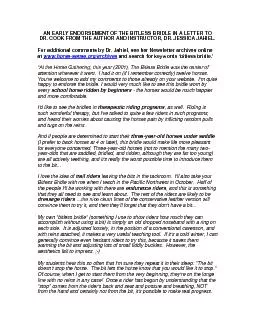/


DR COOK FROM THE AUTHOR AND INSTRUCTOR DR JESSICA JAHIEL For additional comments by Dr Jahiel see her Newsletter archives online at wwwho rse senseorgarchives and search for keywords x2 ID: 156964
Download Pdf The PPT/PDF document "AN EARLY ENDORSEMENT OF THE BITLESS BRID..." is the property of its rightful owner. Permission is granted to download and print the materials on this web site for personal, non-commercial use only, and to display it on your personal computer provided you do not modify the materials and that you retain all copyright notices contained in the materials. By downloading content from our website, you accept the terms of this agreement.
AN EARLY ENDORSEMENT OF THE BITLESS BRIDLE IN A LETTER TO DR. COOK FROM THE AUTHOR AND INSTRUCTOR, DR. JESSICA JAHIEL. For additional comments by Dr. Jahiel, see her Newsletter archives online at www.ho rse - sense.org/archives and search for keywords ‘bitless bridle.’ “At the Horse Gathering, this year (2001), The Bitless Bridle was the center of attention wherever it went. I had it on (if I remember correctly) twelve horses. You're welcome to add my c omments to those already on your website. I'm quite happy to endorse the bridle. I would very much like to see this bridle worn by every school horse ridden by beginners - the horses would be much happier and more comfortable. I'd like to see the bridles in therapeutic riding programs , as well. Riding is such wonderful therapy, but I've talked to quite a few riders in such programs, and heard their worries about causing the horses pain by inflicting random pulls and tugs on the reins. And if people are determined to start their three - year - old horses under saddle (I prefer to back horses at 4 or later), this bridle would make life more pleasant for everyone concerned. Three - year - old horses (not to mention the many two - year - olds that are saddled, bridled, and ridden, although they are far too young) are all actively teething, and it's really the worst possible time to introduce them to the bit... I love the idea of trail riders leaving the bits in the tackroom. I'll also take your Bitless Bridle with me w hen I teach in the Pacific Northwest in October. Half of the people I'll be working with there are endurance riders , and this is something that they all need to see and learn about. The rest of the riders are likely to be dressage riders …the nice clean lines of the conservative leather version will convince them to try it, and then they'll forget that they don't have a bit... My own "bitless bridle" (something I use to show riders how much they can accomplish without using a bit) is simply an old dropp ed noseband with a ring on each side. It is adjusted loosely, in the position of a conventional cavesson, and with reins attached, it makes a very useful teaching tool. If it's a cold winter, I can generally convince even hesitant riders to try this, bec ause it saves them warming the bit and adjusting lots of small fiddly buckles. However, the aesthetics fail to impress. ; - ) My students hear this so often that I'm sure they repeat it in their sleep: "The bit doesn't stop the horse. The bit lets the hor se know that you would like it to stop." Of course, when I get to start them from the very beginning, they're on the longe line with no reins in any case! Once a rider has begun by understanding that the "stop" comes from the rider's back and seat and po sture and breathing, NOT from the hand and certainly not from the bit, it's possible to make real progress. .I was interested in your response to some people’s doubts as to whether your bridle provided a quick enough ‘release’. You wrote … ‘Since the tim e of Xenephon and before, it has been a fundamental of good horsemanship that the rider should give and take (or rather, take and give), pull and release, punish and reward. This is certainly to be desired when using a rod of metal in the mouth to ‘whispe r’ ones wishes. But when this instrument of potential torture is replaced with no more than a benevolent embrace of the whole of the head (as it is with The Bitless Bridle) the principle of punishment and reward is no longer either relevant or required. As the initial whisper of communication is no more than a gentle squeeze, the need for immediate release is no longer paramount. The horse has not been punished and does not look for flattery and coaxing by way of reward. The partnership and trust betwee n horse and rider has never been breached.’ This was nicely put, and I am glad to read these words, because they were almost exactly the ones I used in explaining why “release” wasn’t the horse’s desire or the rider’s goal when this bridle was being used. In any case, rider’s doubts over whether your bridle provided the correct ‘pull and release’ response is a little akin to the pot calling the kettle black. Many riders have their horse’s bits adjusted so high that no genuine release is possible anyway, as the rein pressure is secondary to the constant pressure created by the cheek pieces. One comment that I heard over and over at the Horse Gathering was “There’s no learning curve – the horses just understand this bridle right away.” I think that The Bi tless Bridle fits perfectly with the Natural Horsemanship methods and goals.” - Dr Jessica Jahiel. University of Illinois. Urbana, Illinois (2001)